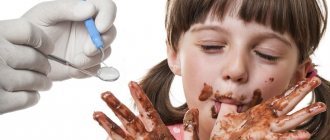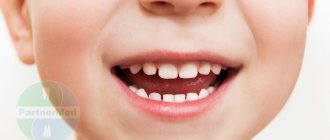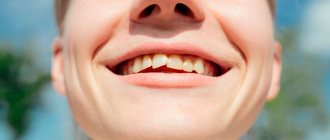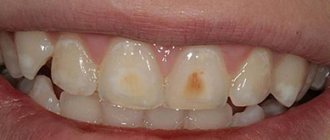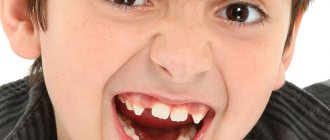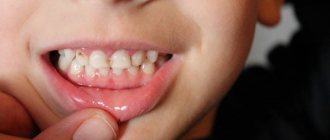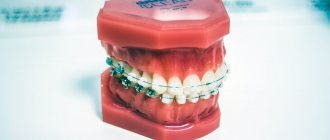Caries can affect children's teeth even at the eruption stage. By the age of 7 years, it is diagnosed in 80% of young patients. But most parents do not focus on this problem. Meanwhile, it is necessary to treat not only permanent teeth, but also milk teeth, since they are also susceptible to pulpitis and can cause purulent infection and other complications. To treat caries in children today, it is not necessary to drill teeth. Modern dentistry has minimally invasive techniques - silvering, fluoridation, infiltration.
Dental treatment for children: yesterday and today
Just 15-20 years ago, finding a specialized clinic or specialized specialist for a child was quite a difficult task, especially in small provincial towns. Children often had to be treated in government institutions, where sometimes even minimal comfort was not provided, which is why many children subsequently suffered from dental phobia. Today the situation has changed dramatically: many private high-class pediatric or family dentistry clinics have appeared, which provide a decent level of treatment and service. The main problem today remains the rather low information awareness of patients, which is why many children do not receive timely treatment and have all sorts of complications.
For example, many parents seriously believe that it is not necessary to treat baby teeth, because they will fall out in any case, so often the child ends up in the dental chair when it is not possible to save the tooth. Of course, this approach is fundamentally wrong. Under the milk teeth are the rudiments of molar teeth, so early loss of temporary teeth or extensive infections threatens a number of complications: from impaired development of permanent teeth to serious dental anomalies. The summary here is obvious: you need to monitor your dental health and eliminate problems in a timely manner from a very early age. Of course, dental treatment for children of different age groups has its own characteristics, so let’s take a closer look at the specific nuances.
Causes of caries in children
The main cause of the disease is poor hygiene. Sometimes, if a patient experiences severe stress or a sudden decrease in immunity, this affects the condition of the teeth. Parents should understand that inflammatory processes can occur even in very young children. That’s why any pediatric dentist so often talks about the importance of proper cleaning and oral care.
Accordingly, the main process for those who want to avoid caries will be home hygiene. Next, we will talk about dangers that are difficult to track right away. For example, what’s wrong when a child falls asleep with a bottle of milk, but you don’t want to wake him up.
What other causes of caries in a child can be? For example, poor nutrition leads to inflammation of the enamel. If the body does not receive enough calcium, protein and other important elements, then the teeth will be weak. As for the popular thesis that caries occurs only from sweets, we will also talk about this later. Don't rush to conclusions!
If a child has constant caries, then there are one or more reasons that you simply do not notice. You shouldn’t think that caries is an exclusively age-related problem and that by the end of school everything will be fine with your teeth. This is a big misconception. It is necessary to treat every case of caries and always find the cause of the problem.
Features of treatment of baby teeth
As a rule, a child’s first teeth appear before reaching the age of one, and at three years old the baby already becomes the proud owner of a full set of milk teeth (20 in total). Considering the anatomy and structure of baby teeth, the treatment of young children has its own characteristics. The enamel of primary teeth is thinner and the connective tissue is looser, so they are much more susceptible to the influence of bacteria and the external environment. Dental treatment methods for children aged one to five years are described below.
Dental treatment for children per year
At the time of teething (especially the first incisors), the gums often swell, the temperature may even rise, so the child experiences discomfort and stress. In this case, the doctor may prescribe medications and gels to alleviate discomfort. At this point, it is also important to choose hygiene products (brushes, fingertips and special toothpaste).
Dental treatment for a 2 year old child
At 2 years old, most of the baby teeth erupt, and it is at this age that the first signs of caries often appear. In the initial stages of the disease, various drugs are applied to the teeth to stop its spread. For the same purpose, they can be fluoridated.
Dental treatment for a 3 year old child
At 3 years of age, all baby teeth usually erupt. At this time, the child often develops a craving for sweet foods and drinks, so carious lesions are not uncommon. At this age, gentle treatment of caries of primary teeth in children is carried out without the use of a drill. However, if the child’s carious lesions are extensive and multiple, sedation or general anesthesia is used. Fissure sealing (grooves on the chewing teeth) is often done.
Dental treatment for a child aged 4 and 5 years
Upon reaching 4-5 years of age, the risk of pulpitis increases in children (especially in the absence of timely treatment). Here it is very important to preserve the root part of the pulp, so dentists usually perform partial removal. However, in advanced cases, the entire tooth is removed, which is extremely undesirable. The ideal option is when by the age of five the child has completely preserved all his milk teeth.
Important!
Before the age of 5-6 years, it is difficult for a child to independently carry out good hygiene, and dental problems in these years are not always accompanied by severe pain. It is important for parents to regularly take their child to the doctor (at least once every 4-6 months), as well as independently monitor his hygiene and properly plan his diet. If you notice black cavities or darkening of the enamel on your teeth, contact a specialist immediately.
Why does the disease occur?
Deep caries can appear in children from three, or even from two years old, if the previous stages of the disease were left unattended.
There may be several reasons.
- An unhealthy lifestyle for the expectant mother is smoking and drinking alcohol in the first trimester of pregnancy.
- The consequence of infections and severe toxicosis.
- Prematurity.
- Infectious diseases suffered by a child in the first months of life.
- Malocclusion.
- Dental caries in the baby's parents.
- Frequent feeding of the child with pureed foods, lack of solid foods in the diet, which leads to insufficient saliva production.
- Excessive amounts of sweets, which promotes the proliferation of pathogenic bacteria, carbohydrate fermentation processes and the formation of lactic acid.
- Lack of foods with phosphorus, fluorine and calcium in the diet, which leads to demineralization of teeth and their gradual destruction.
- Insufficient hygiene. Neglecting simple rules - brushing your teeth twice a day and rinsing your mouth after eating - also negatively affects dental health.
Treatment of permanent teeth in children
Treatment of permanent teeth in children already resembles the “adult” scheme, however, there are some nuances here too. Firstly, the priority remains manipulations without the use of a drill, in particular the so-called infiltration (treatment of teeth with a special polymer composition), ozone therapy and other gentle techniques that are possible only at the “white spot” stage - at the beginning of the development of caries. This works in the primary stages of caries in baby teeth, but in the case of deep and extensive lesions, a drill is no longer necessary. Typically, when treating children's molars, composite or glass ionomer fillings are used, which are considered relatively inexpensive and safe. Many experts recommend sealing the fissures of molar chewing teeth, since it is in this department that caries most often forms. In particular, treatment of the sixth tooth in children may be required much less frequently if the necessary preventive measures are taken. The most negative scenario is when a tooth has to be removed. In this case, a removable denture is made, which the child will have to wear for quite a long time, since implantation can only be carried out after the age of 20, when the jaws are already formed.
| Pain relief techniques | Description |
| Local anesthesia | Local anesthesia is divided into two subtypes: with the administration of drugs by injection (infiltration anesthesia) and without the use of a needle and syringe (application anesthesia). Painkillers during dental treatment for children under five years of age are almost always administered in the second way: these are various gels or aerosols that are used to treat the intervention area. If the child has reached four years of age (this is when the use of ultracaine, articaine and anesthetics based on it is recommended) and is not afraid of injections, infiltration anesthesia can be used. |
| Sedation | Sedation is the safest and most comfortable technology, one of the most common and popular pain management techniques in pediatric dentistry. Using a mask, a mixture of nitrous oxide and oxygen is supplied, which relieves anxiety and relaxes the child. Sedation using propofol is a drug-induced sleep where the drug is administered intravenously and is used for patients over 15 years of age. |
| General anesthesia | Anesthesia in dental treatment in children is used less often than other methods. Complex clinical cases are treated under general anesthesia when large-scale and long-term treatment is required in one session. In addition, general anesthesia is performed for children with mental and neurological problems. Inhalation anesthesia is carried out using a mixture of sevoran and oxygen, also with the use of a mask, which can also be classified as medicinal sleep. For all types of general anesthesia, a numbing injection is used before treatment. |
How caries is treated today for young children under 7 years old
According to statistics, caries is one of the most common diseases in children. It proceeds differently for each preschooler, which requires a different approach to each child. Often, only the restorative procedures described above are sufficient. But sometimes a full-fledged complex therapy with fillings and further preventive monitoring of the oral cavity is required.
Treatment of caries in children is carried out with filling material, which is based on glass ionomer cement. One of the representatives of this group is the drug Vitrebond. With its help, treatment is carried out in a short time, and small lesions under this material are restored quickly and painlessly.
How are children's teeth treated in modern dentistry? The most popular method is chemical-mechanical. A medicinal gel is applied to the infected tooth, which allows you to remove damaged dentin painlessly and without the use of drills. In this case, only dead tissue is removed, so the child does not experience any discomfort or pain. Then the tooth, cleaned of carious surfaces, is filled.
The air-kinetic method allows you to clean a carious cavity using a stream of water, air and abrasive particles that enter the mouth under pressure. This jet, directed at the affected area, “washes away” caries. However, this method is effective only at the initial stage of the disease.
But here another question arises - how is pulpitis of baby teeth treated in children? It will not be possible to do this in one visit to the dentist, since the therapy is carried out in several stages. Treatment can be conservative or surgical, but the second method is not used for baby teeth. Therefore, if conservative treatment for pulpitis does not bring results, it is better to remove the affected tooth.
How to treat the teeth of a child 3 years old or older so that he is not afraid and does not cry? Laser technology helps here. Such devices are not installed in all clinics, but in large cities they are available.
And finally, the use of ozone allows you to quickly and painlessly clean the carious cavity and destroy all microbes that cause the destruction of enamel.
Anesthesia for dental treatment in children
Anesthesia for children during dental treatment is carried out using the same technologies as for adults, but only in smaller dosages of drugs. Due to the fact that most children are afraid of injections, doctors often use alternative methods. Today, several methods are actively used, which are selected depending on the clinical case and psychological characteristics of the child. Each of these methods allows children to undergo dental treatment without pain.
Dangerous symptoms!
After dental treatment, the temperature in children may increase by 1-1.5 degrees. If it does not return to normal within a few days, you should consult a doctor who can prescribe appropriate medications. Never give your child antibiotics or strong antipyretics without the approval of a specialist.
Advantages of this method:
- The development of caries can be stopped in the early stages and for a long time, thereby increasing the life of the tooth.
- No pain, no preparation (drilling) or anesthesia required.
- With this treatment, healthy tooth tissue is preserved, and the treated surface looks like healthy enamel.
- The opportunity to better preserve teeth when there is a particular predisposition to the development of caries (childhood and adolescence, pregnancy, specific diseases, as well as superficial caries caused by poor hygiene, when treated with braces)
- Highly aesthetic treatment (front surfaces of anterior teeth)
- Complete treatment is performed in one visit.
How to choose a clinic for treating children
Dental treatment for children in Moscow is offered by a number of family and children's dentistry, so the quality of services in the capital is quite high due to competition. The same can be said about many other large cities, where specialized dentistry is also opening. The choice of clinic and doctor is important not only from a clinical point of view, but also from the point of view of the child’s psychological health. The best children's clinic is the one that doesn't look like a hospital, so it's the atmosphere that comes to the fore. Thematic design, a decorated children's area, a playful form of treatment, the presence of not only specialized dentists on staff, but also psychologists - options, the presence of which indicates that the clinic has a proven concept and does not just offer a list of services. Be that as it may, before taking your child to an appointment, you need to collect as much information as possible from available sources (clinic website, independent sources on the Internet, patient reviews), and, if possible, personally communicate with the doctor or administrator.
Why parents choose ILATAN dentistry in Moscow
- Here they know how to approach a child.
- If this is the first visit, the patient will be examined and told about how important it is to cure teeth. In our clinic, the treatment procedure is quite tolerable.
- If necessary, “freezing” and light anesthesia are used.
- If the decision is made to remove it, the child is given a non-removable structure in the form of a spacer-ring to preserve space for the future permanent tooth and prevent displacement of the dentition.
The next time the children come to the appointment without fear, and most of them are happy.
To prevent the situation from reoccurring, it is important to periodically conduct preventive examinations.
How much does dental treatment for children cost in Moscow?
The cost of treating children's teeth consists of several components. First, the clinical case itself is assessed. In particular, with serious tooth decay and carious lesions, deeper and more complex treatment is necessary. Much depends on the treatment technology, the materials used, as well as on the level of the clinic itself (the higher its status, the higher the prices). Below is a table in which we have indicated the cost of various services for the treatment of primary and molar teeth.
| Service | Price in Moscow |
| Treatment of simple caries of a baby tooth | From 2,000 rubles |
| Treatment of complex caries of baby teeth | From 3,000 rubles |
| Treatment of molar caries | From 3,000 rubles |
| Treatment of pulpitis | 4,000 - 7,000 rubles depending on the complexity and number of dental canals |
| Treatment of caries without a drill using Icon technology | 5,000 - 7,000 rubles |
| Fissure sealing | 700 - 1,000 rubles per 1 tooth |
| Fluoridation of baby teeth | 3,000 - 4,000 rubles for all baby teeth |
| Air Flow teeth cleaning | 3,000 rubles |
| Removing a baby tooth | 1,500 - 3,000 rubles depending on complexity |
| Molar tooth extraction | From 2,000 rubles |
| Local anesthesia | 500 rubles |
| Sedation | 2,000 - 5,000 rubles depending on the degree of depth and duration |
| General anesthesia | 12,000 - 16,000 rubles |
Every parent, in one way or another, is faced with the question of when to take their child to the dentist. The answer is very simple - when the first tooth erupts. This usually happens by 10 months, but if the tooth is still not visible, then you should even visit a doctor to make sure that the dental system is developing correctly.
The first visit will primarily be intended for parents, to whom the doctor will tell them how to properly care for the child’s oral cavity and how to organize the correct diet. While the child is small, responsibility for the health of his oral cavity, and health in general, falls on the shoulders of the parents. The pediatric dentist will also tell you that visiting the doctor should become a habit and you should appear in the dental chair at least once every six months.
Already from the first teeth, the dentist can notice plaque and bottle caries (damage to baby incisors due to breast or bottle feeding). The sooner the problems are eliminated, the better, because on baby teeth the spread of caries is many times more intense due to weak and thin enamel.
From 1 year to 3 years, a child grows all his baby teeth. At this point, the doctor can already determine the presence of bite pathologies and, if necessary, refer the child to an orthodontist. At the same age, the first professional cleaning and sealing of fissures should be carried out.
How to prepare for your first dentist appointment?
Preparing the child psychologically for the appointment is one of the main tasks of both parents and the attending physician. The success of all further procedures depends on the child’s calmness and willingness to cooperate.
The first visit should have the goal of introducing the child to the doctor, and not treatment. Therefore, you should not wait to choose a pediatric dentist until the first pain and the first noticeable caries. The child should get comfortable and feel comfortable in the office.
A pediatric dentist must have certain knowledge and skills to find an approach to the most closed child, so you should choose a doctor carefully. Once the child understands that the doctor is friendly, he will be able to calm down and understand that there is nothing scary in the dental office.
Parents should make the first trip to the doctor fun and exciting, presenting the process as a game. If adults themselves are afraid of the dentist, then you should not convey your fear to the child in any way; it is better to provide an explanation of the process to the doctor. The main thing is the support of parents throughout all manipulations. You should not raise your voice at your child or force him to behave well if the child does not make contact the first time. In this matter, patience and calmness of both the parent and the doctor are very important.
When visiting a dentist, a child must imagine what will be done to him, so you can prepare for the appointment by studying various videos or texts, and role-playing games are possible. It is fundamentally wrong to tell a child that nothing will be done to him and there will be no pain. Having your mouth examined is also a huge stress for many children. Often, young children cannot distinguish between strong pressure and pain, so any touch from a doctor can be perceived as an attempt to hurt.
To keep the child calm, parents should allow him to take his favorite toy to the appointment. Modern dental offices are equipped with television screens, so the doctor will offer to turn on the child’s favorite cartoon during the entire procedure.
You should not tell your child about your bad experience visiting the dentist as a child. Don't be nervous and let your children know that the upcoming visit is causing them anxiety. You should also avoid the phrase “it won’t hurt,” because if the child is in pain, both the parents and the doctor will lose his trust, and the next trip to the dentist will be perceived as something negative.
To consolidate a positive result in a child, he must be encouraged. It is worth offering the fulfillment of any desire (be it a trip to an amusement park or a new toy). This will motivate the child to behave better.
Why are baby teeth important?
Many parents wonder why they should treat baby teeth, since they will fall out anyway. Often, a visit to the dentist is postponed until the tooth begins to hurt or the defect (hole) becomes very noticeable. In fact, such an accurate point of view is fundamentally wrong, because the health of permanent teeth depends on the health of baby teeth. Everything in our body is interconnected.
If the situation is prolonged, the first experience of visiting the dentist becomes negative. He immediately identifies with pain. A child experiencing pain will not establish contact with a doctor. His agitated state may complicate the treatment process. Anesthesia works less well on neglected teeth, and the child will have to spend much more time in the chair. It is much easier to heal a small hole that the child did not even have time to notice.
Jaw development is directly dependent on the presence of all teeth. The loss of even one tooth can provoke malocclusion, as neighboring teeth will begin to move into empty space, and permanent teeth will erupt behind them in the same position. If one of the baby teeth is lost early, the gums will overgrow and thicken, and the molar simply will not be able to erupt and will remain in the soft tissues. In this case, it can only be removed surgically.
It is in childhood that the correct act of chewing is formed. If one tooth is missing, abnormal development of the maxillofacial area may begin. This will negatively affect not only the facial configuration, but also the child’s posture.
Why is caries of baby teeth so dangerous?
Baby teeth have a unique structure that makes them very vulnerable to tooth decay. The enamel of temporary teeth is very thin and pliable, the dentin layer is also much thinner than in permanent teeth. This contributes to the aggressive course of caries and its rapid transition to pulpitis and periodontitis. The probability of developing caries in children approaches 100%, so every parent will sooner or later face this problem.
Only an erupted tooth also has low resistance to external factors due to the fact that the processes of mineralization in it are still ongoing. Therefore, it is very important to monitor oral hygiene during the eruption of milk and permanent teeth.
Very often, deep caries on baby teeth cannot be cured efficiently, so the teeth must be removed, which leads to the same consequences as early tooth loss. Caries from a baby tooth can easily spread to the crown of a permanent tooth that has not yet erupted. Then the tooth will begin to decay under the gum.
Complications of dental caries can cause the formation of purulent processes both in the maxillofacial area and in the body as a whole, which can threaten the health and even the life of a small child. All pathological processes in the body of a small patient proceed faster and more aggressively, which is associated with a not yet fully developed immune system.
To prevent such unpleasant consequences and reduce the risks to zero, you need to carefully monitor your child’s teeth and prevent the development of caries. The main rule in dental care is complete, high-quality oral hygiene. The pediatric dentist will tell you how to carry it out correctly.
When to start brushing your teeth?
The opinion of dentists on this matter is clear - from the first erupted tooth. For babies, a special finger brush is used. The bristles on it are narrow, no more than the width of one child’s tooth, and very soft so as not to damage the soft tissues of the oral cavity. You should brush your teeth using a special children's toothpaste, which is gentle on the tissues of the newly erupted tooth. When breastfeeding and bottle-feeding through a pacifier, the risk of developing bottle and circular caries increases, so parents should devote enough time to quality cleaning.
The role of the behavior of the parents themselves is important. After all, they are the first and main role models for a small child. From childhood, you need to instill a love for morning and evening hygiene procedures. This will help your child form useful habits that he will follow in his independent life.
To attract the attention of young children to brush their teeth, the brush should be bright and the handle comfortable. Hygiene procedures should be carried out in a playful way. The child should also like the toothpaste; it is better not to choose toothpaste with menthol, which has a rather aggressive effect on the mucous membrane. There are many flavors of toothpastes on the dental market. It is worth choosing it based on the child’s preferences.
Why do you need a pediatric dentist?
The specificity of the work of a pediatric dentist is that he will have to communicate not only with an adult, but also with a small patient. Often it is impossible to explain everything to children the same way as adults. The pediatric dentist must find a way to the heart of the little patient and win his trust. Therefore, such a doctor must also be an excellent psychologist.
A pediatric dentist must be very patient, because it is not always possible to seat a small patient in a chair the first time, and also force him to open his mouth for at least 20 minutes. If a child closes his mouth and bites his fingers, the dentist must tolerate it, because this is a very common occurrence in pediatric dental practice. Often you have to very clearly explain your actions to the parents of a small patient; they are very vigilant for the health of their child.
Due to the anatomical and physiological characteristics of baby teeth, their destruction occurs much faster than if the same process occurred in permanent teeth. The process is aggressive, and the tooth pulp can become infected even when the carious process has only just been noticed, and the tooth has not even begun to hurt. It is not always possible to carry out high-quality endodontic treatment; often the tooth must be removed. If root canal filling is possible, then such treatment takes at least three visits. And this is with only one tooth.
Children's teeth are often affected by circular caries - a pathological process localized in the neck of the tooth crown and spreading to all its surfaces. Because of this, the neck of the tooth becomes thinner and the crown can break off even from slight pressure. Such caries is insidious in that most often the process begins on the oral side of the tooth, invisible to the naked eye. To avoid further development of this disease, you need to attend preventive examinations with a pediatric dentist, who, using a special mirror, carefully examines all surfaces of the teeth, even the most difficult to reach.
Dental treatment for children under anesthesia
Nowadays, medical technology does not stand still. Heavy anesthetic drugs that require a difficult recovery from anesthesia have long been no longer used. For children, special dosages have been invented that allow the baby to fall asleep in his mother’s arms and wake up 20 minutes after the end of treatment and go home in a good mood with healthy teeth, not remembering anything about dental procedures. The safety of using such drugs is guaranteed. Modern methods of general anesthesia exclude any side effects on the baby’s nervous system, his mental and physical development.
This method of pain relief is also used for allergic reactions to local anesthetics. Before the procedure, a mandatory consultation with an anesthesiologist is carried out. The combination and doses of drugs are calculated individually for each patient. After awakening from anesthesia, most often there are no changes in the behavior of children. Although it is possible that after returning from sleep, the baby may be too excited or overtired.
Where to begin?
First, you should make an appointment for an in-person consultation with our pediatric dentist. At the first appointment, the doctor will get to know the baby and try to establish contact with him. After the child begins to trust him and calms down, the doctor will be able to examine the oral cavity and tell the parents which teeth require treatment. You can make an appointment by phone. indicated on the website, and find out the current prices in the appropriate section. Healthy teeth – happy baby!

